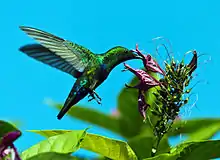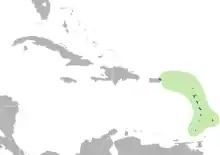Green-throated carib
The green-throated carib (Eulampis holosericeus) is a species of hummingbird in the genus Eulampis, which contains one other species. It has two subspecies, holosericeus and chlorolaemus, the former occurring in Puerto Rico and the latter in Grenada.
| Green-throated carib | |
|---|---|
 | |
| in Barbados | |
| Scientific classification | |
| Kingdom: | Animalia |
| Phylum: | Chordata |
| Class: | Aves |
| Order: | Apodiformes |
| Family: | Trochilidae |
| Genus: | Eulampis |
| Species: | E. holosericeus |
| Binomial name | |
| Eulampis holosericeus | |
 | |
| Synonyms | |
|
Trochilus holosericeus Linnaeus, 1758 | |
Taxonomy
The green-throated carib was formally described by the Swedish naturalist Carl Linnaeus in 1758 in the tenth edition of his Systema Naturae under the binomial name Trochilus holosericeus.[2] Linnaeus based his description on the "black-belly'd green huming bird" that had been described and illustrated by the English naturalist George Edwards in 1743.[3] The type locality is the Lesser Antilles.[4] The specific name is from the Ancient Greek holosērikos meaning "silken".[5] The green-throated carib is now placed in the genus Eulampis that was introduced by the German zoologist Friedrich Boie in 1831.[6][7]
Two subspecies are recognised:[7]
Description
The green-throated carib is a large hummingbird. Adult females have some feathers orange to light green below the peak, while adult males have light green in greater proportion. Also the tail in adult females is dark red-brown with tips ending in white, the tail of the male is dark blue. Both females and males have an intense blue band on the chest, belly of both are dark green-blue. The back of both is green with golden tones.
Distribution and habitat
It is found in the Caribbean islands and Lesser Antilles, locations including Anguilla, Antigua and Barbuda, Barbados, Dominica, Grenada, Guadeloupe, Martinique, Montserrat, Puerto Rico, Saba, Saint-Barthélemy, Saint Kitts and Nevis, Saint Lucia, Saint Martin, Saint Vincent and the Grenadines, Sint Eustatius, the British Virgin Islands and the U.S. Virgin Islands.
Its natural habitat is semi-deciduous forests and rainforests. It will also occupy open spaces such as parks and cultivated fields.[8]
Behaviour
Its vocalizations consist of a sharp "chup" or "tsip", which it repeats when alarmed It also produces nonvocal sounds with its wings.[9]
See also
References
- BirdLife International (2012). "Eulampis holosericeus". IUCN Red List of Threatened Species. 2012. Retrieved 26 November 2013.CS1 maint: ref=harv (link)
- Linnaeus, Carl (1758). Systema Naturae per regna tria naturae, secundum classes, ordines, genera, species, cum characteribus, differentiis, synonymis, locis (in Latin). Volume 1 (10th ed.). Holmiae (Stockholm): Laurentii Salvii. p. 120.
- Edwards, George (1743). A Natural History of Uncommon Birds. Part 1. London: Printed for the author at the College of Physicians. p. 36, Plate 36.
- Peters, James Lee, ed. (1945). Check-List of Birds of the World. Volume 5. Cambridge, Massachusetts: Harvard University Press. p. 27.
- Jobling, James A. (2010). The Helm Dictionary of Scientific Bird Names. London: Christopher Helm. p. 194. ISBN 978-1-4081-2501-4.
- Boie, Friedrich (1831). "Bemerkungen über Species und einige ornithologische Familien und Sippen". Isis von Oken (in German). Cols 538–548 [547].
- Gill, Frank; Donsker, David; Rasmussen, Pamela, eds. (January 2021). "Hummingbirds". IOC World Bird List Version 11.1. International Ornithologists' Union. Retrieved 30 January 2021.
- "Green-throated Carib (Eulampis holosericeus)". Handbook of the Birds of the World. Retrieved 17 August 2016.
- "Eulampis holosericeus". neotropical birds - cornell. Retrieved 17 August 2016.
